A smooth man on the ivories, hot on the trigger, and cool in a jam – he’s the toughest private eye to hit America in a decade. From the great new television series starring John Cassavetes comes this novel of love in Greenwich Village, murder in midtown, beats on the Bowery, sex on Sutton Place and blackmail, racketeering, and violence in the worlds most savage city.
 Take a good novel, and someone will eventually turn it into a movie or TV show. But take a good (or even bad) TV show or movie and turn it into a good book? That rarely happens. There are plenty that go through that process now a days where mixed media is the norm; think Star Wars, Star Trek, The Monk books (which are actually pretty good, especially since one of the original script writers wrote the novels.)
Take a good novel, and someone will eventually turn it into a movie or TV show. But take a good (or even bad) TV show or movie and turn it into a good book? That rarely happens. There are plenty that go through that process now a days where mixed media is the norm; think Star Wars, Star Trek, The Monk books (which are actually pretty good, especially since one of the original script writers wrote the novels.)
After ten minutes of extensive research – counting the time mixing a martini –I can’t determine the very first example of a movie or TV show being turned into a novel, so we’ll just say that “Johnny Staccato” was it.
From the mid 50’s on, television tried, and sometimes succeeded in cashing in on the popularity of “The Beat Generation” generally making it a parody and stereo typing it with only a superficial nod to Jack Kerouac.  This was a time when the parents of the “Baby Boomers” were starting to mature. They were, like the Beat Generation which they were a part of, throwing off traditional values, rejecting authority, anti-conformist, freer sexually, and creating their own art. This was the birth of be-bop jazz, coffee houses with poetry readings, drug use for recreational purposes was accepted in bigger and bigger social circles, but above all, they were cool. And, if you are on this page you know there was never a cooler cat in fiction than the hardboiled detective. He was an individualist. Possessed only a grudging respect for the police, and had his own sense of right and wrong. Probably the first of this new generation was Richard Diamond, Private Detective played on radio from 1949-1953 by Dick Powell who reprised the role on TV from 1957 til 1960 starring David Jansen of The Fugitive fame.
This was a time when the parents of the “Baby Boomers” were starting to mature. They were, like the Beat Generation which they were a part of, throwing off traditional values, rejecting authority, anti-conformist, freer sexually, and creating their own art. This was the birth of be-bop jazz, coffee houses with poetry readings, drug use for recreational purposes was accepted in bigger and bigger social circles, but above all, they were cool. And, if you are on this page you know there was never a cooler cat in fiction than the hardboiled detective. He was an individualist. Possessed only a grudging respect for the police, and had his own sense of right and wrong. Probably the first of this new generation was Richard Diamond, Private Detective played on radio from 1949-1953 by Dick Powell who reprised the role on TV from 1957 til 1960 starring David Jansen of The Fugitive fame.
Sam, his secretary was played by Mary Tyler Moore, or more precisely, her legs. She revealed this “secret” in the 70’s and promptly lost her job selling Leggs panty hose in commercial. Richard Diamond was written by Blake Edwards. Edwards also gave us probably the most memorable, if only for the theme song, TV detectives of the era, Peter Gunn.  Peter Gunn is a private investigator in the classic film noir tradition, which was a popular genre on American TV in the late 1950s. However, a few traits differentiate him from the standard hard-boiled detectives, such as Sam Spade or Philip Marlowe. Gunn was a sophisticated hipster, a dapper dresser who loved cool jazz; where other gumshoes were often coarse, Peter Gunn was portrayed as the epitome of cool. He operated in a nameless waterfront city, and was a regular patron of Mother’s, a wharf side jazz club. the theme song, composed by Henry Mancini is one of the most popular from TV.
Peter Gunn is a private investigator in the classic film noir tradition, which was a popular genre on American TV in the late 1950s. However, a few traits differentiate him from the standard hard-boiled detectives, such as Sam Spade or Philip Marlowe. Gunn was a sophisticated hipster, a dapper dresser who loved cool jazz; where other gumshoes were often coarse, Peter Gunn was portrayed as the epitome of cool. He operated in a nameless waterfront city, and was a regular patron of Mother’s, a wharf side jazz club. the theme song, composed by Henry Mancini is one of the most popular from TV.
Peter Gunn with it’s jazzy theme was shown on NBC and moved to ABC for the last season. when it moved to ANC, NBC tried to replace it with Johnny Staccato starring John Cassavetes. As you can tell from the ‘tag’ at the top, Johnny Staccato is a jazz pianist/private detective. The setting for many episodes is a Greenwich Village jazz club belonging to his friend, Waldo, played by Eduardo Ciannelli. The show featured many musicians, such as Barney Kessel, Shelly Manne, Red Mitchell, Red Norvo, and Johnny Williams, all jazz greats. Elmer Bernstein composed the main theme.
The show, like Star Trek in the 60’s, was one of those shows that acquired a cult following but didn’t do much else. It aired from September 1959 til March of 1960, 27 episodes. It did feature some great guest stars that would go on to TV and Hollywood stardom. Amongst them Gena Rowlands, Martin Landau, Michael Landon, Cloris Leachman, Elizabeth Montgomery, Mary Tyler Moore (she made the rounds of the detective shows), Dean Stockwell, Geraldine Brooks and Lloyd Corrigan. It’s star, John Cassevetes didn’t care for the show and had only taken the job to pay off some personal debts. Cassavettes went so far as to publicly criticize the show in his successful effort to escape in his contract in the middle of the season. The big difference between Peter Gunn and Johnny Staccato, other than the fact that, Peter Gunn tended to leave a lot of dead bodies lying around at the end of each episode where Staccato ended many episodes with no dead bodies, is that jazz isn’t just something he hangs around to gather clues, but he’s truly a part of it as a musician. Staccato is a jazz pianist who, according to the TV show, wasn’t quite good enough, so he got his PI license. In the book, he gave up music as a living to make more money as a PI. The scenes of Staccato on the piano are priceless. The music of the late 50s, the “cool jazz” played by those all-star bands, pulses through Johnny Staccato.A great majority of the episodes were classic, and well written by some very good writers.
One of those writers was author Frank Kane aka Frank Boyd of the Johnny Liddell novels. Frank Kane wasn’t a genius, a great innovator or the world’s greatest stylist, but he never failed to deliver the goods, constantly and consistently, in solid, workmanlike prose that always entertained, and rarely disappointed. As fellow crime writer Bill Crider put it on Rara-Avis in April 2000, if it’s a Frank Kane book, chances are "it’ll be a competent, straightforward P.I. story." And that is what he delivered with Johnny Stacatto, the novel.
The novel actually deals with a social issue that was fresh in the public mind at the time the show aired. The Payola Scandals of the mid 50’s. The story opens up with ex-girlfriend, blond bomb shell, and sultry singer, Shelly Carroll coming to see Johnny at Waldo’s, the basement jazz club. She’s got a problem. She’s going to be suspected of murder, Les Miller, a disc jockey who had the industry wrapped up tighter than Dick’s hat band with his ability, and inclination to make or break singers, song writers or record companies by pushing or burying their music. Shelley had gone to see Les and found him murdered and hasn’t reported it. But the clerk at the hotel saw her, and soon he will try and black mail her into “playing house” to buy his silence. When Johnny goes to the murder scene to look around, he finds a partial glass of bourbon as well as the dead mans glass. Then someone wearing tasseled loafers knocks him out and the police arrive.The police come quickly to suspect Shelley when the clerk reveals her name after she turns him down, with Johnny’s help, for a little hanky-panky. This alienates Lt. Phil Kovacs, his policeman friend when it is discovered that Johnny didn’t tell him that Shelley had been in the room. Johnny tells Kovacs that it couldn’t have been Shelley because of the glass of bourbon, and Shelley is allergic to bourbon, but this carries no weight with the police or the D.A.  So, more suspects come into the picture. A mob type, named Dom Traina and one of his strong armed/wanna be Sinatra goons who wears loafer like the ones Johnny saw on the guy that slugged him. From there he ends up in the Brill Building, the home of “Poverty Row” – the Tin-Pan Alley of the story. We learn of Delia Moore, the singer that Les Miller had ruined when she wouldn’t “play house” with him.he black balled her in the music industry and gave all her good material to Shelley’s . There’s also Frank Seymour, a publisher who is a straw man; “only a beard-Les Miller owns his company” as Rudy Marcus, the A-R man tells Johnny. Marcus had promised Shelley he’d talk to Les Miller about letting her back in the game and was supposed to see Miller the night he was killed. Marcus tell Johnny, “I’m going to his funeral. But only to make sure they screw the top down real tight.” Half the music industry, and the crooks in it have a reason to have killed Miller. Seymour stands to now make money from his company with Miller dead because he won’t have to kick back profits, It could be Dom Traina or his goon, since Miller refused to let Traina’s boy, Tony Varon have any good songs and everybody knows Dom gets what Dom wants. And Miller had made purposeful mistakes to embarrass Varon on the air. This is motive enough for Dom and Varon .Miller had driven Delia Moore right out of the business, so she had a motive. Rudy Marcus himself is a suspect because he was lusting after Delia, and by Miller being dead, she could be a star again. With this many suspects, and time out for some bit players, like Barney the clerk to distract us with dead ends, some suitable jive-jazz patios stirred in with hardboiled patter and similes that Chandler might just have employed, we have the makings of a first rate crime novel.
So, more suspects come into the picture. A mob type, named Dom Traina and one of his strong armed/wanna be Sinatra goons who wears loafer like the ones Johnny saw on the guy that slugged him. From there he ends up in the Brill Building, the home of “Poverty Row” – the Tin-Pan Alley of the story. We learn of Delia Moore, the singer that Les Miller had ruined when she wouldn’t “play house” with him.he black balled her in the music industry and gave all her good material to Shelley’s . There’s also Frank Seymour, a publisher who is a straw man; “only a beard-Les Miller owns his company” as Rudy Marcus, the A-R man tells Johnny. Marcus had promised Shelley he’d talk to Les Miller about letting her back in the game and was supposed to see Miller the night he was killed. Marcus tell Johnny, “I’m going to his funeral. But only to make sure they screw the top down real tight.” Half the music industry, and the crooks in it have a reason to have killed Miller. Seymour stands to now make money from his company with Miller dead because he won’t have to kick back profits, It could be Dom Traina or his goon, since Miller refused to let Traina’s boy, Tony Varon have any good songs and everybody knows Dom gets what Dom wants. And Miller had made purposeful mistakes to embarrass Varon on the air. This is motive enough for Dom and Varon .Miller had driven Delia Moore right out of the business, so she had a motive. Rudy Marcus himself is a suspect because he was lusting after Delia, and by Miller being dead, she could be a star again. With this many suspects, and time out for some bit players, like Barney the clerk to distract us with dead ends, some suitable jive-jazz patios stirred in with hardboiled patter and similes that Chandler might just have employed, we have the makings of a first rate crime novel.
Kane/Boyd’s dark descriptions of New York and it’s seedier parts is evocative of the noir atmosphere . The characters are very well developed and the intricate descriptions of the payloa driven music industry and it’s workings are educational. Johnny Staccato is well worth the read if you can find a copy and it is also available for free download in many eBook formats on Munsey’s. There is also a DVD Box Set available on Amazon that would be well worth having.
For a nice bio on Frank Kane alias Frank Boyd, the prolific hardboiled writer, check out the Thrilling Detective site where they have a memoir, exclusive to Thrilling Detective by Maura Fox and her reminisces about her grandfather.
The Dirty Lowdown
















